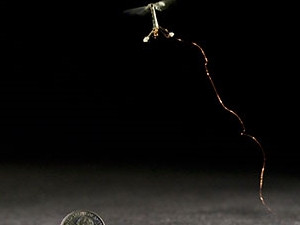
Researchers at Harvard University achieved take-off with the first controlled flight of their mechanically engineered robotic insect.
During a test flight in the Harvard robotics laboratory last year, a prototype robotic insect managed to fly several inches into the air. RoboBee also managed to hover and flutter along a pre-set route through the air during the test flight.
The insect, called RoboBee, is half the size of a paperclip, weighs less than a tenth of a gram and is the culmination of more than a decade's research and work, says the university.
The research paper was published this week by graduate students Pakpong Chirarattananon and Kevin Y Ma, and the project was led by researchers at the Harvard School of Engineering and Applied Sciences (SEAS) and the Wyss Institute for Biologically Inspired Engineering at Harvard.
Robert J Wood, Charles River professor of Engineering and Applied Sciences at SEAS and principal investigator of the RoboBee project, says the project only came to life through the latest advancements in the manufacturing of materials and design.
Wood says it has not been a smooth ride to get RoboBee up in the air. "We had to develop solutions from scratch, for everything. We would get one component working, but when we moved onto the next, five new problems would arise. It was a moving target. Flight muscles, for instance, don't come pre-packaged for robots the size of a fingertip."
Ma says the research team has gone through 20 prototypes in just the past six months. "We can now very rapidly build reliable prototypes, which allow us to be more aggressive in how we test them.
"Large robots can run on electromagnetic motors, but at this small scale you have to come up with an alternative, and there wasn't one," he adds.
The prototype RoboBees are still tethered by a thin power cable as there is no off-the-shelf solution available to store energy in such a small unit. Control of the RoboBee is also still wired in from a separate computer.
Micro innovation
Associate professor of the University of Stellenbosch's mechanical and mechatronic department, Kristiaan Schreve, says what is so significant about what the researchers at Harvard have done is that they created a prototype that can be used to mass-produce the robot, or even to quickly create alternative prototypes.
"They have also miniaturised all the mechanics of the robot. Their research opens doors for others working in this field. Applications of this technology could have an impact on many sectors like biomedical engineering, prosthetics, surveying, search and rescue, spying, agriculture, etc."
Schreve says there is a significant research effort towards micro-manufacturing as opposed to nano-manufacturing and macro-manufacturing. "Micro-manufacturing can be considered to be manufacturing of objects up to a few centimetres in size, but with very small features; for example, holes with micron-sized diameters."
He adds that manufacturing these components requires new methods that must be more precise than existing approaches and it deals with physical effects that are not present at the macro-level.
Schreve says there are local projects focusing on the same technology. "The Council for Scientific and Industrial Research (CSIR) has micro-manufacturing and micro-fluidics laboratories. At Stellenbosch University, we are also looking at micro-manufacturing, with a specific focus on developing new methods to measure (for quality control) such components."
He adds that it is important to realise this manufacturing paradigm will require new manufacturing, assembly and quality control methods. "However, the research institutes are battling to find funding. The technology is too early in the development stage for industry to adopt and support the development; therefore government funding is urgently needed."
Implementation
According to the university, the RoboBee project could be used for environmental monitoring, search-and-rescue operations, or assistance with crop pollination.
It adds that the materials, fabrication techniques, and components that emerge from the project might prove to be even more significant.
Harvard's Office of Technology Development, in collaboration with Harvard SEAS and the Wyss Institute, is already in the process of commercialising some of the underlying technologies.
Schreve says the Harvard researchers have chosen a really challenging and eye-catching problem to demonstrate the miniaturisation technology. "It shows that it can be done and will lead others to develop more everyday applications - just watch how a James Bond movie excites your imagination for all the possibilities of miniaturised gadgets."
Share